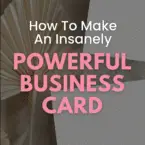
In today’s hyper-digital era, you may be wondering, does anyone still use business cards? The answer, surprisingly, is a resounding yes. Despite living in an age of LinkedIn profiles and digital contacts, a powerful business card retains its prime position in the professional world.
It’s more than just a tangible manifestation of your contact details. Instead, it’s a physical expression of your professional identity. It is a compelling snapshot of who you are, what you do, and how you do it. It is the smallest, pocket-friendly billboard that advertises you and your brand.
A powerful business card is an extension of your professional persona, paving the way for opportunities and partnerships.
The Unforgettable Business Card Anecdote
Let’s step into the shoes of Jane, an ambitious entrepreneur who had just started her journey. Jane found herself at a bustling business conference, surrounded by potential partners, investors, and clients. Amidst exchanging pleasantries and ideas, came the inevitable exchange of business cards. Here, amidst a sea of plain white cards, one particular card stood out. It was brilliantly designed and made a strong impression with its look and feel. The owner? A start-up founder like herself. Jane found herself drawn to the founder, and the memorable business card sparked a conversation that eventually led to a fruitful business partnership.
What was the magic ingredient that initiated this beneficial interaction? An insanely powerful business card. This anecdote perfectly encapsulates the importance and potential power a well-designed business card can have in facilitating critical professional connections. Stay with us as we explore how you can create your own power-packed business card.
1. Understanding Your Brand
What is Your Brand and Why is it Essential?
Before we journey into the realm of crafting a powerful business card, we must first anchor ourselves in a clear understanding of your brand. So, what exactly is a brand? Your brand is not merely your company’s name or its logo. It is a comprehensive entity that encompasses your business’s vision, mission, values, personality, and the emotions it evokes in your customers. In essence, it’s the complete experience that your business offers.
Understanding your brand is crucial. It serves as your business’s compass, guiding all your decisions and interactions. Moreover, it’s the unique fingerprint that sets you apart in a sea of competitors. It’s the promise you make to your customers and the experience you consistently deliver that fulfills this promise. By understanding your brand, you can articulate a clear message about your business, one that resonates with your target audience and creates lasting impressions.
Identifying the Elements that Represent Your Brand
An essential part of understanding your brand is recognizing the elements that visually represent it. These elements act as the visual language communicating your brand’s essence without words. They are instantly recognizable, and they consistently represent your brand across different platforms. Here are a few elements you should consider:
- Logo: Your logo is the visual cornerstone of your brand. It’s the symbol that embodies your brand and makes it instantly recognizable.
- Color Scheme: Colors are deeply tied to emotions and perceptions. The colors you choose for your brand should reflect the feelings and messages you want to convey.
- Typography: Fonts speak volumes about your brand. A carefully chosen font can communicate your brand’s personality before a single word is read.
- Images and Graphics: The style of images and graphics you use in your branding contributes to the overall perception of your brand.
- Tone of Voice: How your brand communicates verbally is another significant element of your brand. It’s about the words you choose, the order in which you put them, and the tone you use in your messaging.
In our journey to creating a powerful business card, these branding elements act as our North Star. They guide the design process, ensuring that the final product is not just a card, but a miniature, portable embodiment of your brand.
Let’s move on to the structural aspects of crafting a potent business card.
2. The Anatomy of an Effective Business Card
Business cards may be small, but they are mighty, especially when they are well-designed. Each element of a business card plays a crucial role in communicating your professional story. Let’s dissect the anatomy of a powerful business card and understand the importance of each component.
Importance of Each Element in a Business Card
An effective business card is more than just a repository of your contact details. Each component – from your name and title to your contact information and social media handles – conveys something significant about your professional identity. They collectively form the narrative of who you are, what you do, and how you can be reached.
Guidelines on What to Include
When designing your business card, it’s essential to strike the right balance between providing enough information and maintaining a clean, uncluttered design. Here’s a rundown of the core elements you should consider:
- Your Name: This is the focal point of your business card. It’s the first thing people see, so ensure it’s clearly visible and printed in an easy-to-read font.
- Title or Profession: This informs the receiver about what you do. Keep it concise and straightforward, yet descriptive enough to give a clear idea of your role or your business.
- Contact Information: This typically includes your phone number, email address, and website. However, only include the methods of communication you prefer or use the most.
- Social Media Handles: In the digital age, your professional social media profiles serve as additional platforms to showcase your work or business. If relevant, include the handles of your professional social media profiles like LinkedIn, Twitter, or Instagram. Remember to keep your social media presence consistent with your brand.
- Logo and Branding Elements: Your business card should be an extension of your brand identity. Include your logo, and use your brand’s color scheme and typography to create a card that is a visual representation of your brand.
Every piece of information and design choice on your business card should serve the central purpose of providing a powerful, succinct introduction to you and your brand. Remember, the goal is not just to create a memorable business card but to craft a potent tool for connection and opportunities.
3. Designing Your Business Card
Designing a powerful business card involves making critical decisions about size, orientation, colors, fonts, whitespace, balance, and materials. Each choice you make will add a unique dimension to your card and help it stand out. Let’s explore these design elements in detail.
Card Size and Orientation
Standard business card size varies by country. In the US, it’s typically 3.5 x 2 inches, while in Europe, it’s commonly 85 x 55 mm. However, you can play around with dimensions to create a unique look, but keep in mind that unconventional sizes may not fit in standard business card holders.
Orientation plays a significant role in the overall feel of your card. While a horizontal orientation is traditional and provides a familiar feel, vertical orientation can make your card stand out and gives it a modern, edgy vibe.
Use of Colors and Fonts: What Works and What Doesn’t
Color can significantly influence the perception of your brand. Ensure your color choices align with your brand’s personality. Bold, vibrant colors might work well for a creative business, while subdued hues may be suitable for corporate or traditional professions. Also, it’s essential to ensure high contrast between your text and background for legibility.
The fonts you choose say a lot about your brand. Serif fonts might suggest a traditional, respectable business, while sans-serif fonts often feel modern and clean. Make sure the font is easily legible, even at small sizes.
Use of Whitespace and Balance
Whitespace, or negative space, is an often overlooked element in design. Effective use of whitespace can make your business card feel open, clear, and uncluttered, making it easy for the eye to focus on the important details.
Striking a balance in your design is vital. Balance doesn’t necessarily mean symmetry, but rather an equilibrium between different elements such as text, logos, and color blocks.
Consideration of Materials and Finishes
The feel of your card plays a crucial role in how it is perceived. Consider the thickness of the cardstock— too thin might come off as cheap, while too thick may be cumbersome. Textured cardstock can add a touch of luxury, as can finishes such as gloss, matte, or metallic. Consider environmentally friendly options like recycled paper if it aligns with your brand values.
Designing a business card is an exercise in branding, creativity, and strategy. Make sure each element you choose aligns with your brand identity and serves to create a powerful business card that leaves a lasting impression.
Next let’s journey into the realm of originality and unique business card ideas.
4. Making Your Business Card Unique
Your business card should be more than just a tool to share contact information. It’s a physical representation of your brand that people can hold, feel, and remember. In an age of digital overload, a unique business card can leave a lasting impression, make you stand out, and give you an edge over your competition.
The Power of Originality: Creating a Card That Stands Out
The most powerful business card is the one that doesn’t end up in the trash. And for that, it needs to stand out. So don’t be afraid to step away from convention and try something different. Remember, the card is a reflection of your brand’s personality. So, if your brand is daring, creative, or fun, let that shine through your business card.
Innovative Business Card Ideas: QR Codes, Unique Shapes, Textures, etc.
Innovative features can turn your business card into a talking point, increasing the chances it’ll be kept and remembered. Here are a few ideas:
- QR codes: A QR code can instantly direct people to your website, portfolio, LinkedIn profile, or any other online platform. It’s a neat, interactive feature that can boost your online presence.
- Unique shapes: Break the rectangular mold. Opt for a circular card, or one shaped like an object relevant to your business – a baker could have a bread-shaped card, for example.
- Textures: Add a tactile dimension to your card with embossed text or logos. Or use different materials like metal, wood, or even transparent plastic to make your card feel special.
- Multipurpose cards: Can your card double as a bookmark, a tiny notebook, a sticker, or even a cheese grater? Get creative with how your card can be used beyond holding information.
Case Studies of Successful, Unique Business Cards
Many businesses have reaped the benefits of daring to be different. For instance, LEGO’s business cards are custom-made LEGO figures that resemble the employee, complete with their name and contact info. It aligns perfectly with their brand, is memorable, and adds a dash of fun!
In the world of design, Broke Bike Alley turned their business cards into mini bike repair tools, cementing their brand in the minds of their customers each time they use the tool.
Making your business card unique is an investment in your brand. It’s an opportunity to showcase your creativity and leave a powerful impression. So think outside the ‘rectangle,’ and create a powerful business card that’s truly one-of-a-kind!
Indeed, a blend of professionalism and personality can make a business card all the more memorable. Let’s delve into this:
5. Keeping It Professional Yet Personal
Crafting a powerful business card is a fine balancing act. You want to maintain professionalism, but you also want to infuse a bit of your personality into it. This blend can help establish a deeper connection with your audience, making you and your business more memorable.
Striking the Balance Between Business and Personal Elements
The key here is to remember that while your business card is a reflection of you, it’s primarily a tool for your business. Thus, you should always lead with the professional. Include your name, your professional title, and your business contact information. Then, weave in personal elements that enhance and complement these professional details, such as a unique design aspect that speaks to your personal style, or a favorite quote that reflects your approach to business.
When and How to Use a Photo
Including a photo on your business card can be powerful, but it’s not always the right choice. If you’re a freelancer or a solo entrepreneur, a photo can help forge a personal connection. It’s also beneficial for people who meet a lot of new faces in their line of work, as it helps others remember them.
However, if you choose to use a photo, it must be professional. A poor quality or inappropriate image can detract from your brand. Consider hiring a professional photographer, choose a picture that represents you at your professional best, and make sure the image quality holds up in the small card format.
Incorporating Elements of Your Personality
Here’s where you can truly make your card shine. Do you have a signature color, a unique hobby, or a distinctive style? Incorporating these into your card can make it distinctly yours.
For example, if you’re known for your sense of humor, perhaps a witty tagline would work well. If you’re a fan of a particular era of design, such as mid-century modern or Art Deco, incorporating elements of that style can add a personal touch.
The goal of a business card is not just to provide contact information. It’s a tangible piece of your personal brand that leaves an impression. A powerful business card marries professional essentials with personal flourishes to create a small but potent symbol of who you are and what you represent.
6. The Don’ts of Business Card Design
When it comes to designing your business card, avoiding common mistakes is as vital as implementing effective strategies. Missteps can lead to an ineffective card that doesn’t resonate with your audience or, worse, negatively impacts your brand image. Here’s what you should avoid:
Common Mistakes and Pitfalls to Avoid
- Poor Readability: Your business card must be legible. Avoid using extremely small fonts, overly ornate typefaces, or colors that are hard to read. Clarity should always take precedence.
- Overcrowding: While it’s important to provide necessary information, cramming too much onto the card can lead to a cluttered, unappealing look. Stick to essentials and use the power of whitespace to keep it clean and balanced.
- Subpar Printing: Even a great design can fall flat with poor quality printing. Make sure you use a trusted printing service that can replicate your design accurately and with quality materials.
- Forgetting the Back: Many people neglect the back of their card, but this is valuable real estate. You can use this space to add additional information, your brand’s tagline, or even a compelling call to action.
Missteps That Can Harm Your Brand Image
- Inconsistency: Your business card should align with your overall brand identity. If your card’s design conflicts with your other marketing materials, it can lead to confusion and dilute your brand.
- Outdated Information: The moment your contact details change, you should update your business card. Handing out cards with outdated or incorrect information is unprofessional and can harm your brand image.
- Neglecting Proofreading: Typos or grammatical errors on your business card can come across as careless, so proofread carefully.
- Lack of Originality: With so many business cards out there, an unoriginal design can make your card easily forgettable. Don’t be afraid to infuse some creativity into your design to help it stand out.
By avoiding these common missteps, you can ensure that your business card will be a potent tool in your professional arsenal, effectively representing you and your brand in the best light possible.
You’ve done the work, avoided the pitfalls, and crafted a truly compelling business card. Now, let’s delve into the broader role it plays in networking:
7. The Role of a Business Card in Networking
Many consider business cards to be just vessels for contact information. Still, they play a much more profound role, acting as a tangible extension of your professional persona, and as a catalyst for relationship building.
The Function of a Business Card Beyond Just Providing Contact Information
- A Snapshot of Your Professional Identity: Your business card is a miniature representation of your professional self. Beyond just your name and contact details, it conveys your brand, your role, and your unique value proposition.
- A Memorable First Impression: Often, the business card serves as the first tangible impression of your business. A well-designed, powerful business card can leave a long-lasting positive impact, paving the way for future interactions.
- A Call to Action: Your business card can encourage the recipient to take the next step, whether that’s visiting your website, checking out your portfolio, or scheduling a follow-up meeting.
How a Great Business Card Can Facilitate Relationship Building
- Stand Out From the Crowd: A powerful business card can distinguish you from the masses. An engaging design, innovative idea, or unique finish can serve as a conversation starter, making people more likely to remember you.
- Facilitate Follow-Up: When you meet someone interesting, a business card exchange sets the stage for future contact. With your details in hand, it’s easier for potential partners or clients to reach out.
- A Constant Reminder: Unlike digital information that can get lost in the cloud, a physical card serves as a constant reminder of your meeting, keeping you top of mind.
In the era of digital communication, business cards retain their tangible charm. They offer a personal, powerful, and purposeful way to share your professional information, all while paving the way for fruitful relationships.
You’ve designed an alluring business card that captures your brand and piques interest. Now, it’s time to bring your vision to life with the perfect printer. Let’s guide you through the process:
8. Finding the Right Printer
Selecting a printing service can feel as challenging as designing the business card itself. After all, the quality of printing can amplify or dampen your card’s impact. Here’s what to keep in mind:
Key Considerations When Selecting a Printing Service
- Quality: The foremost consideration should always be quality. Request samples to evaluate the printer’s craftsmanship, print clarity, and material quality. Your powerful business card deserves nothing but the best.
- Options: Does the printer offer the variety of materials, finishes, and printing methods you’re seeking? The more options available, the closer you’ll get to realizing your unique vision.
- Customer Service: Look for a printer that’s responsive, attentive, and supportive, particularly if you’re new to the process.
- Price: While you want a top-tier result, it’s essential to find a service that fits within your budget. Keep in mind, though, that sometimes, paying a little extra can make a significant difference in quality.
Options for Printing: Local vs. Online, Mass-Produced vs. Artisanal
When deciding where to print your business cards, you have several options:
- Local Print Shops: These provide personalized service and the opportunity to see and feel samples firsthand. Plus, you’ll be supporting local businesses.
- Online Printers: With a wide array of options, competitive pricing, and home delivery, online printers offer convenience and variety.
- Mass-Produced vs. Artisanal: Mass production is an affordable option when you need a large number of cards, while artisanal printers specialize in bespoke designs and high-end finishes that will really make your powerful business card stand out.
Your business card is an extension of your professional identity. Therefore, don’t rush the printing process; find a service that aligns with your needs, matches your standards, and complements your card’s design.
As we approach the end of our expedition into the realm of business cards, it’s time to take a step back, assimilate the whirlwind of information, and prepare to embark on a journey of creation:
9. Final Thoughts
A powerful business card is a potent tool in your professional arsenal. More than a vessel for your contact details, it’s a snapshot of who you are, what you stand for, and how you want the world to perceive you. It embodies your brand, differentiates you from the crowd, and facilitates meaningful connections.
Over the course of this article, we’ve journeyed together through the various facets of creating an impactful business card. Now, it’s over to you. Armed with these insights, you’re all set to create a powerful business card that is not only a beacon of your brand but also a key that unlocks potential networking doors. We’re rooting for you – go forth and create a card that leaves a lasting impression!
Frequently Asked Questions (FAQs)
How Can I Make My Business Card Stand Out?
Making your business card unique is all about creativity and branding. Incorporating brand elements like your logo, color scheme, and fonts can enhance recognition. Additionally, consider using innovative ideas like QR codes, unique shapes, or textures. Striking the balance between professional and personal elements also helps to create a memorable card.
What Information Should I Include on My Business Card?
Your business card should essentially be a compact representation of your professional identity. Include your name, job title, company name (if applicable), contact information (email, phone number), and social media handles. Adding your company logo can boost brand recognition. Ensure the information is accurate and up-to-date.
What are Common Mistakes to Avoid When Designing a Business Card?
Avoid cluttering your business card with too much information or using overly complex designs that might detract from the key information. Also, stay away from low-quality printing or paper, as it might negatively affect your brand’s image. Always proofread your card to avoid any typos or errors.
How Can a Business Card Facilitate Networking?
A business card is a physical reminder of your professional interaction with someone. It provides essential contact information for follow-ups, but it can also spark conversations if it has a unique design or includes interesting personal elements. A well-designed business card can thus facilitate relationship-building and networking.
What Should I Consider When Selecting a Printing Service for My Business Card?
When choosing a printing service, consider the quality of printing they offer, as it reflects on your brand. Check customer reviews and samples of their work. Also, compare prices and consider the advantages and disadvantages of local versus online services and mass-produced versus artisanal options.






